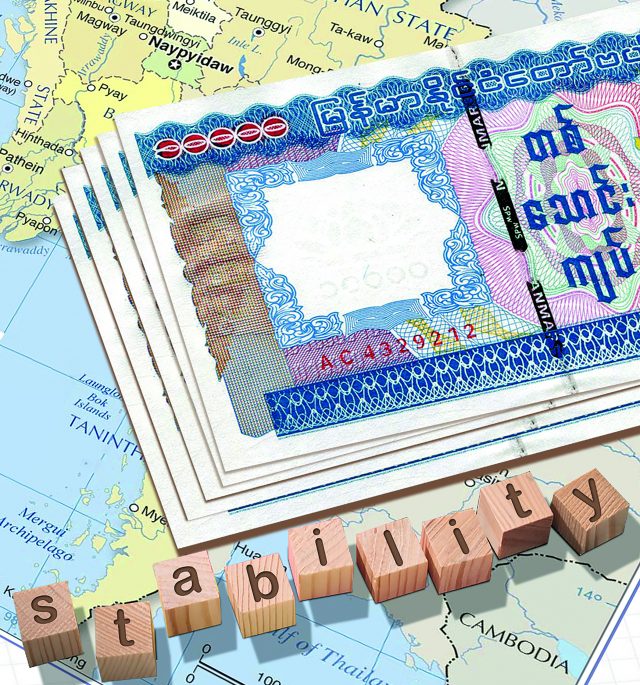One year has passed since the military took control of the government due to NLD and its appointed elections committee’s failure to investigate significant voters’ fraud. A lot has happened since then; many assassinated for supporting the new administration, many killed for refusing to support NNCP (NUG, NLD, CRPH, PDF) terrorists, many businesses destroyed due to social punishment decided by street justice and kangaroo courts, many civil servants murdered for simply not supporting the CDM (Civil Disobedience Movement), many monks executed simply for being in an area where the terrorists operates. Bombing campaigns against public infrastructure had hurt many services; banks, schools, hospitals, bridges, roads, terminals, petrol stations were all not spared. The most impacted ones remained the bombing of telecom and electricity transmission towers. All could be easily destroyed with a single explosive device, yet the restoration of services back to normal would take months.
May be due to lack of education or judgement, Myanmar people are easily swayed by fake news, gossip and misinformation. Yet, most are beginning to realise the crimes that NNCP terrorists have committed as well as rampant corruption that happened under NLD administration. Now the crimes stated above have been put under control and the country is now on a clear path towards prosperity in the (Myanmar) New Year.
Yet the most challenging issue that Myanmar is facing right now is not any of the above described. Because of the terrorist activities against major businesses in Myanmar, the economy contracted quite significantly in 2021. World Bank, International Monetary Fund and Asia Development Bank put the GDP contraction figures between 10 – 20%. Yet the actual numbers might be higher. For the upcoming 2022, the three international organisations put the forecast GDB growth around 0%. The country’s output and productivity had ground to a halt last year. Combined that with increase in the import costs due to Kyat depreciation, fuel cost increases, rises in logistics fares, the country is facing significant cost push inflationary pressures. Factoring in businessmen and general traders expectation of inflation, we now have a recipe to enter into a period of hyperinflation.
How does hyperinflation set in, in the first place? Myanmar has now all the right ingredients:
Tax revenues reduction: Due to CDM and general boycott against the new government of last year, a significant population of people refuses to pay taxes they owed to the government and even for the electricity that they personally consume. Combined that with the lower government income from corporate taxes due to economic contraction, a sizeable portion of government’s revenues would be missing for the 2021 and 2022.
Quantitative easing: In order to keep the economy growing and save the banking sector (so far no banks has gone out of business, since the change of government), the government has to print more money, especially since the banks no longer allow cash withdrawals on demand. This add more money in the hands of the people and businesses as cash in hand. Not trusting the banks, people are still holding onto these cash or converting them into gold or $ and holding onto these.
Cost push increases: Myanmar is essentially an import depended country. From raw materials to construction equipments to consumer electronics, imports are essential part of the country’s economic machine. The fuel and $ cost increases hit the imports hard. Even the locally made products are not spared either, due to the increase of the former. Bricks, sand and gravels for construction are produced locally, not affected by the exchange rate, yet, the prices for these are now nearly twice as much a year and half ago.
These three ingredients, once they take shape, they will have the multiplier effect, seeding further inflation and eventually a hyper inflationary environment. If uncontrolled, it can lead to the collapse of the currency and finally the economy.
What actions can the government take?
Obviously, drastic situations called for drastic measures. Every action in economics comes with a side effect. The government can mitigate these yet they cannot be avoided.
The government can use wage and price controls to fight inflation, but the downside would be a likely recession and further job losses. State Administration Council (SAC) is doing it right. Central Bank of Myanmar (CBM) is funding the purchase of fuel, edible oil, etc., to stem the tide of cost push price increases, through discounted exchange rates. Labor market wages have been left to operate without interference. The upward pressure on wages is still not in existence at this level, due to structural employment arising from the economic contraction.
The government can employ a contractionary monetary policy by reducing money supply within the economy and through increased interest rates. For this to happen, the banking system has to be back to normalcy. As long as the banks refused to allow cash withdrawals on demand, the government has to augment the supply shortage through printing of more money, thereby rising inflationary pressures. Some banks are working to get back as close to normal as possible, yet there are some below par, who still refuses withdrawals of any kind. These banks no longer have a role to play in society and the government must take tough action to shut them down or let them be absorbed by a larger organisation. SAC has the hard task of having to restore consumer and business people confidence in Myanmar commercial banks and shutting down those errant banks would be one of the mandatory steps. So how does the government find out which banks are taking consumers for a ride. Simple! Just look at the percentage that consumers have to give to for cash withdrawals (CWD) to bank staff or brokers (illegal activity, of course). While mainstream banks such as AYA, KBZ and CB are running at less than 2%, smaller bank such as GTB still attracts around 7% as CWD percentage charge. The rate is a reflection of how difficult it is to make a CWD out of a particular bank. The higher the rate is, the more difficult it is to take your own cash out of the bank that you once trusted.
The last tool that the government could use is to increase the reserve requirement of banks on the amount of money banks are legally required to keep with the central bank. The more money banks are required to hold back, the less they have to lend to consumers, which would consequently result in decreased spending in the economy. Again, this tool may not be suitable for Myanmar at this point of time, as the banks may be having a liquidity crisis and may not be able to accommodate an increase in reserve requirement. At the same time, not much lending is happening in the economy at this point of time, so an additional inducement to reduce spending may not be essential at this point of time.
Actions to be taken at individual level
While it is the action of the government, CBM governor and Finance Minister that would halt the hyperinflation in its track, at the micro level, there are actions that we as individuals can take to mitigate the negative impacts of hyperinflation.
- Reduce transport expenses: With crude prices hitting the roof and $ following in the same direction, an oil importing country like Myanmar, is facing significant increases in fuel prices. Ways to limit the increase would be to cut down unnecessary travels, car pooling, trying to organise, accomplish multiple tasks along the same route, switching to a more fuel efficient car, etc. Every little thing helps and every little savings in fuel consumption will be keenly felt at month end. Take care of the pence and the pounds will take care of themselves!
- Stop buying new things: New products, new items or new arrivals may look and feel good, yet they come with newly inflation adjusted prices. Worse, the sellers may even input the expected higher inflation of the future into the products. The trick here is to look at second hand products of good condition and quality. Social media pages such as Yangon Connection, may be a good start. People sell every thing from used office furniture to household goods to generators. The sellers bought these goods at pre-inflation prices and these goods are being sold at a discount to that. You can even haggle and prices can go really low sometimes.
- Have a back up plan for every home appliance, in case of breakdown: That would force us to think whether we really need to buy new items at an instant. Air conditioner alternative fan, Generator alternative solar, TV alternative of YouTube or Netflix, should be considered in case of equipment breakdowns, saving your money from high products prices.
- Gold and silver are very inflation proof, so it would be wise to consider converting part of your cash into these two inflation proof assets.
- Buy household supplies that are long lasting, right now. Prices are going to go up later and you are definitely going to require these items. Baking soda, washing liquids, detergent, bleach, vinegar, insect repellent, etc., are examples of such items.
- Commit yourself to lesser to no restaurant outings: As inflation sets in, cost of everything would go up, including meals and dining. One of the best way to shield yourself against the increases would be to stop going out to eat altogether. These include food delivery services too.
- Convert your Kyats into stable currencies. It may sound non-nationalistic, yet it remains one of the solutions. Hard currencies seldom suffer from hyperinflation and holding notes in these currencies would be a wise move during the hyperinflation period.
- Find new sources of income: Because of hyperinflation, your purchasing power have definitely gone down. Hence an alternative source of income or every single extra income would help at least maintain your current purchasing power.
- Grow your own source of food and water supply: These are your staple items in your daily basket of necessities. If you have your own sources for that, you definitely would be better protected from increases in daily essentials. Those with land spaces, it would be a good idea to start your own homestead, with livestock and agriculture up and running.
- Beef up home and personal security: We have not got the confirmed police statistics yet, but if the news are indicative of the general populous, more petty crimes are happening everyday across major cities. These can suddenly escalade into muggings and robberies. So safety can security should be upgraded during this high inflationary environment.
- Stay positive: Hyper inflation would not be with us forever. It would be gone in a year or so. The world would go on. Businesses would continue. Some would come out better, some would be much worse. Keeping yourself in a positive frame of mind would kept you away from depression and encourage you to excel during this difficult period.
Good luck and get prosperous in the New Year!










